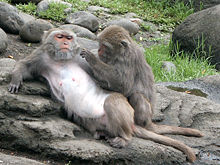Formosa macaque
| Formosa macaque | ||||||||||||
|---|---|---|---|---|---|---|---|---|---|---|---|---|

Formosa macaques |
||||||||||||
| Systematics | ||||||||||||
|
||||||||||||
| Scientific name | ||||||||||||
| Macaca cyclopis | ||||||||||||
| ( Swinhoe , 1863) |
The Formosa or Rundgesichtsmakak ( Macaca cyclopis ) is a primate species from the genus of macaques within the family of Cercopithecidae (Cercopithecidae).
description
The fur of these animals is dark brown or gray in color, the belly is lighter, sometimes slightly bluish. The round, hairless face is brown in color. The head body length of these animals varies from 40 to 55 centimeters and the weight from 4 to 8 kilograms, with the males becoming larger and heavier than the females. The tail is medium in length, around 26 to 45 centimeters.
distribution and habitat
Formosa macaques are endemic to Taiwan (formerly Formosa), especially in the northeast and southwest of the island. In the past, they often lived near the sea, but human settlement activities have pushed them to remote regions in the interior of the island. Their habitat is often rocky areas with few or no trees, but sometimes also temperate forests.
Way of life
These animals are diurnal and mainly stay on the ground. Like many other macaque species, they live in groups that consist of several males and females and their offspring. Earlier reports speak of groups of up to 45 people, due to the reduction in living space, groups of 2 to 10 animals are common today. They are territorial animals, but the territories can partially overlap.
food
Formosa macaques are omnivorous. Their diet includes plant material such as fruits, leaves and seeds as well as insects and small vertebrates. When they were still at the sea, crabs were also part of their diet.
Reproduction
After around 165 days of gestation, the female usually gives birth to a single young between April and June. After around a year, it is weaned and sexually mature at around two to four years. Females stay in their birth group for their entire life; males have to leave this group when they reach sexual maturity. Life expectancy is not known; comparisons with related species suggest around 30 years in human care and a little less in the wild.
threat
Formosa macaques are hunted because they sometimes devastate plantations, because they are wanted as pets or laboratory animals, and sometimes because of their meat. Human settlement activity on Taiwan has pushed them back to remote regions in the interior of Taiwan. Overall, according to the IUCN , the species is not endangered due to the stable population ( least concern ).
literature
- Thomas Geissmann : Comparative Primatology. Springer-Verlag, Berlin et al. 2003, ISBN 3-540-43645-6 .
- Don E. Wilson, DeeAnn M. Reeder (Eds.): Mammal Species of the World. A taxonomic and geographic Reference. Johns Hopkins University Press, Baltimore MD 2005, ISBN 0-8018-8221-4 .
Web links
- Information on theprimata.com
- Information on primatis.de
- Information from the Animal Diversity Web
- Macaca cyclopis in the endangered Red List species the IUCN 2010. Posted by: Hai Yin, W. & Richardson, M. 2008. Accessed June 14, 2011th


